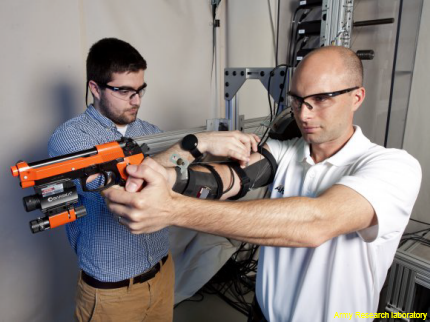Army's exoskeleton improves marksmanship
ARL's MAXFAS reduces involuntary tremors and improve the shooting proficiency of soldiers.

ARL researchers test MAXFAS on simulated shooting.
Military researchers are developing exoskeletons that can help soldiers more easily carry their loads and avoid injury. Now, a new piece of robotics and exoskeleton technology can help them shoot straight.
The MAXFAS developed by the Army Research Lab is a mechatronic arm exoskeleton used to train novice marksmen and soldiers to more quickly reach shooting proficiency.
"Soldiers need to be able to aim and shoot accurately and quickly in the chaos of the battlefield," ARL mechanical engineer Dan Baechle said. "Training with MAXFAS could improve Soldiers' accuracy, and reduce current time and ammunition requirements in basic training."
The MAXFAS can correct subtle tremors in a shooter’s arm that can inhibit firearm accuracy – think of the slight movements of a laser pointer on a blackboard when pointed at arm’s length. And the corrections from MAXFAS seem to stick with soldiers, who saw improved accuracy after the exoskeleton was removed, the Army said.
The technology for MAXFAS was borrowed from the medical field for stabilizing victims of stroke, then enhanced with lighter carbon fiber and modeled for marksmen stabilization for either on-the-spot shooting or long-term shooting proficiency. The lighter carbon fiber modification from the medical iteration was aimed at limiting the already excessive weights of equipment soldiers are forced to carry.
The exoskeleton works by mounting motors for the cable driven arm behind the user to pull cables attached to arm braces. Sensors then detect involuntary tremors and send signals to the motor to correct it without restricting the user’s voluntary motion.
"My vision is that one day, a more mature version of MAXFAS could be used to improve aim on the battlefield despite any adverse conditions," Baechle said. Stressful battle situations combined with fatigue that could affect one’s accuracy provide an ample opportunity for such a product to deploy and evolve in the future, he said.